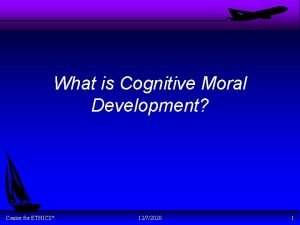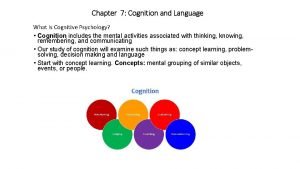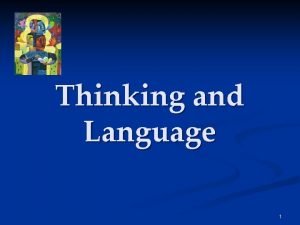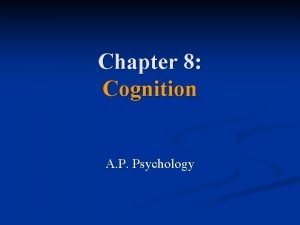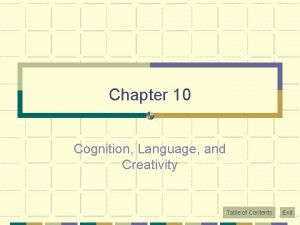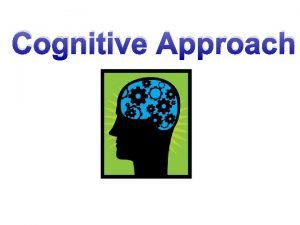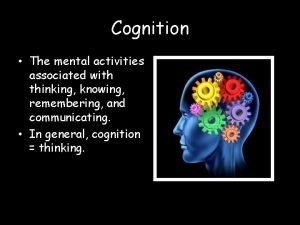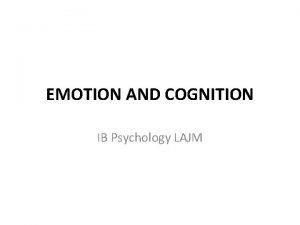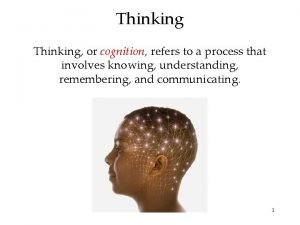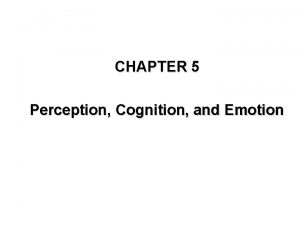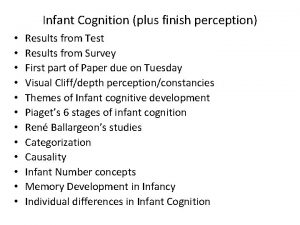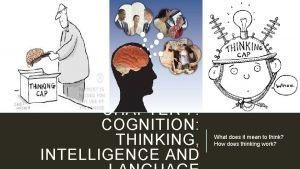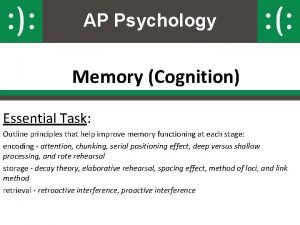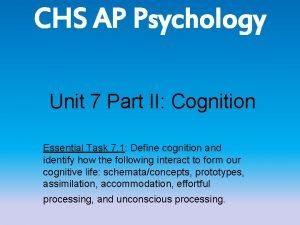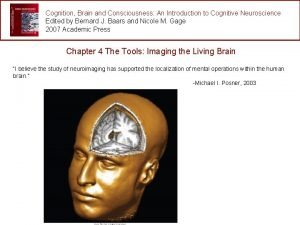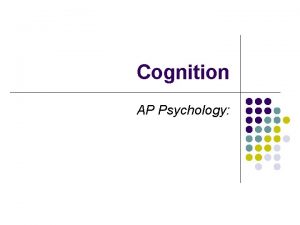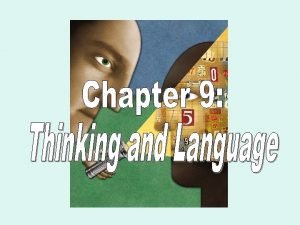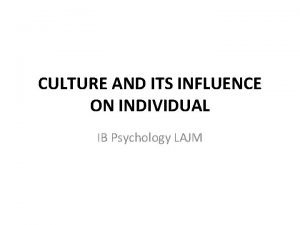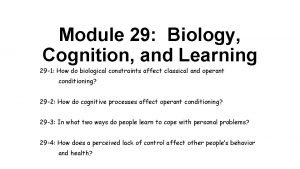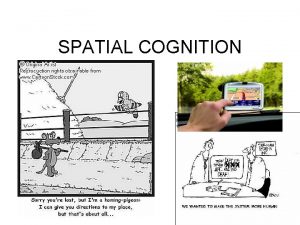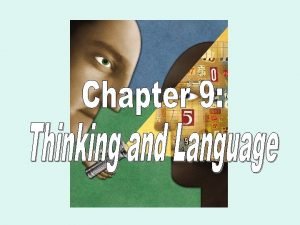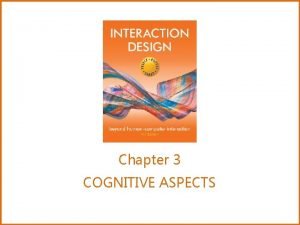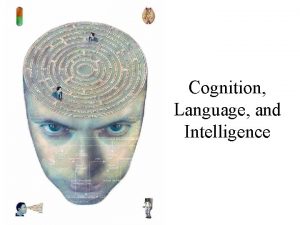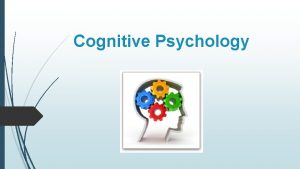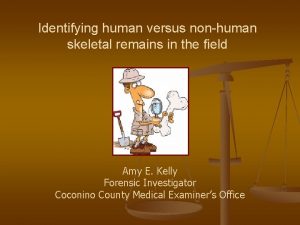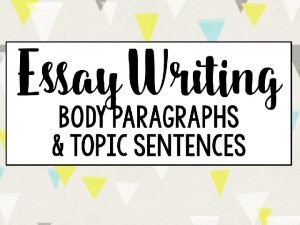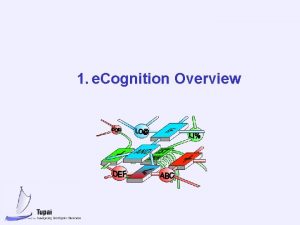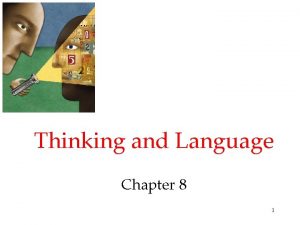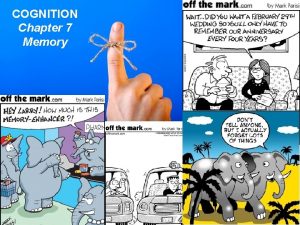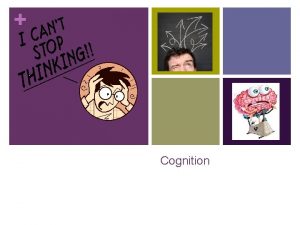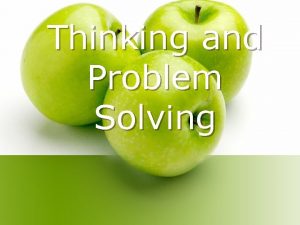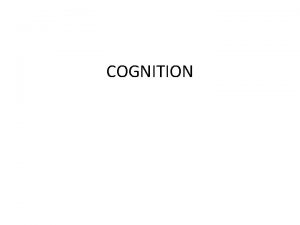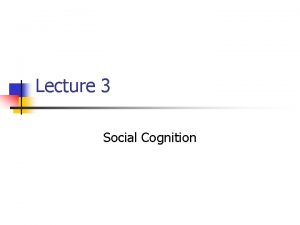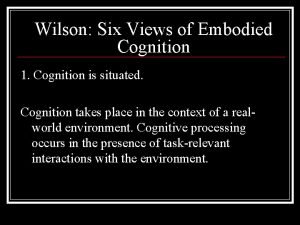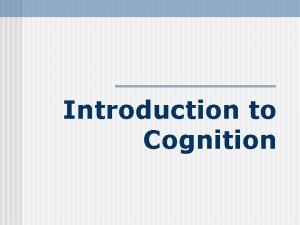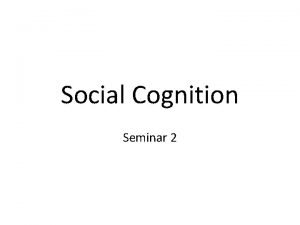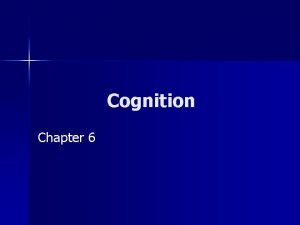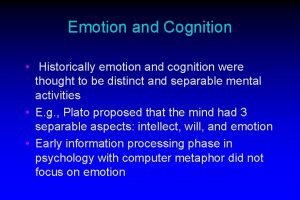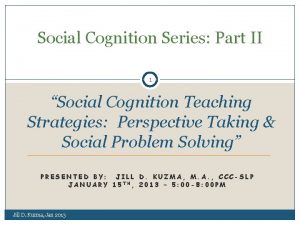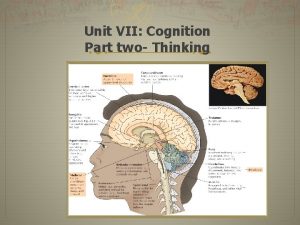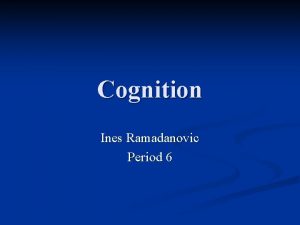Human Cognition What is cognition 1 Overview of







































- Slides: 39

Human Cognition • What is cognition? 1


Overview of Human-Computer Systems Muscular Feedback Cognitive Functions Sensory Systems: Human Input Motor Functions: Human Output The Human-Computer Interface Displays: Machine Output Controls: Machine Input Feedback within Machine Mechanisms of Machine: Performs Task and Determines State

A Human Information Processing Model after Wickens (1984) Attentional Resources Short-Term Sensory Store Perception Long-Term Memory Decision Making Working Memory (Immediate Memory) Memory Feedback Response Execution

Attention • What is it? • Why do we say that we have attention?

Attention and Visual Search 3500 Feature Present Conjunctive Present Feature Absent Conjunctive Absent Reaction Time (msec) 3000 2500 2000 1500 1000 500 0 4 16 Number of Distractors 64

Spatial Cuing 400 Reaction Time (msec) 350 300 250 200 150 100 50 0 Valid Neutral Cue Type Invalid

Attention and Automaticity Stroop Effect Reaction Time (msec) 1600 1400 1200 1000 800 600 400 200 0 Same Different Text vs. Color

Knowledge of Results (Feedback) and Practice • With sufficient practice, KR can be removed without loss of performance (Newell, 1974).

Multitasking and attention • Is it possible to perform multiple tasks without one or more of them being detrimentally affected? • Ophir et al (2009) compared heavy vs light multi-taskers • heavy were more prone to being distracted than those who infrequently multitask • heavy multi-taskers are easily distracted and find it difficult to filter irrelevant information www. id-book. com 10

So we sample sources of information Probability of Sample Sampling 1 0, 9 0, 8 0, 7 0, 6 0, 5 0, 4 0, 3 0, 2 0, 1 0 Ideal 0 0, 2 0, 4 Probablility of Event 0, 6 0, 8 1 Actual

What makes sharing easier or harder (Wickens, 1984)

The Process Model of Memory Encoding Storage Retrieval A memory failure may be due to a failure at any stage.

A Human Information Processing Model after Wickens (1984) Attentional Resources Short-Term Sensory Store Perception Decision Making Working Memory Long-Term Memory Feedback Response Execution

Immediate Memory: Capacity Memory Span 7 6 5 Memory Span 4 3 2 1 0 Numbers Letters: Sound Diff : Rhyme Words 1 Syl Words 2 Syl

What some designers get up to… • Present only 7 options on a menu • Display only 7 icons on a tool bar • Have no more than 7 bullets in a list • Place only 7 items on a pull down menu • Place only 7 tabs on the top of a website page • But this is wrong? Why? www. id-book. com 17

Immediate Memory: Duration and Function Brown-Peterson Proportion Recalled 0, 9 0, 8 0, 7 0, 6 0, 5 0, 4 P&P (1959) 0, 3 0, 2 0, 1 0 0 5 10 Delay (sec) 15 20

Long-Term Memory: Encoding Levels of Processing 1 0, 9 Proportion Correct 0, 8 0, 7 0, 6 0, 5 0, 4 0, 3 0, 2 0, 1 0 Case (Physical) Rhyme (Auditory) Study Condition Category (Semantic)

Long-Term Memory: Storage & Retrieval DRM False Memory 100, 00 90, 00 80, 00 Percentage Recalled 70, 00 60, 00 50, 00 40, 00 30, 00 20, 00 10, 00 In Orig List Normal Distractor Special Distractor

What do you remember the most? 6 Frequency Recalled More Than Other 5 4 3 2 1 0 In Orig List Special Distractor Item Type

Long-Term Memory: Context Percent Correct 100 Encoding Specificity 90 Test Context None 80 Cue A 70 Cue B 60 50 40 30 20 10 0 None Cue A Study Context Cue B

Serial Position Effect 120% Percent Recalled 100% 80% Immediate 60% Delayed 2 nd try 40% 20% 0% 1 2 3 4 5 6 7 8 9 10 11 12 13 14 15 16 17 18 19 20 Word Position

Release from Proactive Interference Release from PI Percentage Recalled 100% 90% 80% 70% 60% 50% 40% 30% 20% 10% 0% 1 2 3 4 Trial 5 6

Recognition versus recall • Command-based interfaces require users to recall from memory a name from a possible set of 100 s • GUIs provid. MP 3 players visually-based options that users need only browse through until they recognize one • Web browsers, etc. , provide lists of visited URLs, song titles etc. , that support recognition memory www. id-book. com 26

Memory aids • Sense. Cam developed by Microsoft Research Labs (now Autographer) • a wearable device that intermittently takes photos without any user intervention while worn • digital images taken are stored and revisited using special software • Has been found to improve people’s memory, suffering from Alzheimers www. id-book. com 27

Sense. Cam www. id-book. com 28

Language • The ease with which people can read, listen, or speak differs www. id-book. com 29

Speech: The sound spectrogram

Ambiguity in the Speech Stimulus: Coarticulation Ba Bee Boo

Mc. Gurk Effect

Context helps: Speech Blanking • Try this link

Problem-solving • All involves reflective cognition • e. g. thinking about what to do, what the options are, and the consequences • Often involves conscious processes, discussion with others (or oneself), and the use of artefacts • e. g. maps, books, pen and paper • May involve working through different scenarios and deciding which is best option www. id-book. com 34

9 dot problem


Luchins Water Jar Problems How would you use 3 jars with the indicated capacities to measure out the desired amount of water? Problem 1 Problem 2 Problem 3 Problem 4 Problem 5 Problem 6 A 3 8 5 6 3 4 B 77 80 43 42 49 48 C 21 4 12 9 23 18 DESIRED 50 60 21 21 20 22

Luchins Water Jar Problems How would you use 3 jars with the indicated capacities to measure out the desired amount of water? Problem 1 Problem 2 Problem 3 Problem 4 Problem 5 Problem 6 A 3 8 5 6 3 4 B 77 80 43 42 49 48 C 21 4 12 9 23 18 DESIRED 50 60 21 21 20 22 solution B-C-2 A B-C-2 A, but also C-A A simpler solution exists for problems 5 and 6, but subjects reached a state of “Einstellung” where they kept applying old successful problem solving methods.

Luchins Results Group Einstellung Solution (percent) Direct Solution (percent) No Solution (percent) Control 0 100 0 Experimental 74 26 0 (Control subjects did not have the first four problems)

True Story • A professor comes to a University to give a talk. They up a slide projector for him, but neglect to test it. During the talk it becomes apparent that the projector is set too low. Graduate students and professors gather around the projector trying to fix the problem. They call out for a book to raise the front end of the projector. The book turns out to be too thick. They call out for a thinner book. . . While everyone is searching for another book, one person comes over and quietly solves the problem. . . Punchline. All these academics in one room, and nobody knows how to open a book? ? (from Ashcroft, 2002)

Another problem • A man climbs a mountain on Sat, leaving at daybreak and arriving at the top at sundown. He spends the night, gets up the next day at daybreak and heads down the mountain, following exactly the same path he climbed the day before. • Question: will there be any time during the second day when he will be at exactly the same point on the mountain he was at that time the first day? B A SAT SUN
 Overview of hrm
Overview of hrm Konsep ketersediaan heuristik
Konsep ketersediaan heuristik Moral cognition
Moral cognition Means end analysis psychology example
Means end analysis psychology example Cognition refers to
Cognition refers to Embodied cognition ap psychology
Embodied cognition ap psychology John wurzel
John wurzel Cognition definition
Cognition definition Cognition definition
Cognition definition All the mental activities associated with thinking
All the mental activities associated with thinking Teacup ib psychology
Teacup ib psychology Example of cognitive dissonance
Example of cognitive dissonance Cognition vs perception
Cognition vs perception Cognition plus
Cognition plus Cognition thinking intelligence and language
Cognition thinking intelligence and language Cognition mse
Cognition mse Cognition ap psych definition
Cognition ap psych definition Priming memory examples
Priming memory examples Embodied cognition ap psychology definition
Embodied cognition ap psychology definition Consciousness
Consciousness Unlike b. f. skinner, noam chomsky believes that children
Unlike b. f. skinner, noam chomsky believes that children Altered cognition in older adults is commonly attributed to
Altered cognition in older adults is commonly attributed to Cognition refers to
Cognition refers to Odden & rochat (2004)
Odden & rochat (2004) Module 29 biology cognition and learning
Module 29 biology cognition and learning Cognition and personalization
Cognition and personalization Chapter 7 cognition thinking intelligence and language
Chapter 7 cognition thinking intelligence and language Xxxفضایی
Xxxفضایی Representative heuristic
Representative heuristic Definition of telegraphic speech in psychology
Definition of telegraphic speech in psychology What is cognition
What is cognition Cognition language and intelligence
Cognition language and intelligence What is cognition
What is cognition Chapter 8 human needs and human development
Chapter 8 human needs and human development Human development index definition ap human geography
Human development index definition ap human geography Human vs non human bones
Human vs non human bones Non human nouns
Non human nouns Chapter 8 human needs and human development
Chapter 8 human needs and human development Enron overview
Enron overview Background information body
Background information body


